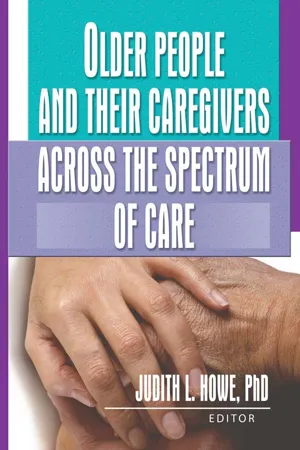
- 173 pages
- English
- ePUB (mobile friendly)
- Available on iOS & Android
Older People and Their Caregivers Across the Spectrum of Care
About This Book
Examine recently developed concepts and strategies to help social workers and caregivers improve the quality of care for senior citizens! Older People and Their Caregivers Across the Spectrum of Care focuses on two major aspects of elderly care: assessment and caregiving. This book examines assessment techniques and models used by social workers and other health care professionals to determine the type and extent of care necessary to meet the needs of the elderly. In addition, it voices recent concerns about the use of standardized models for all older adults. This book also addresses the burdens and benefits of being a caregiver to older relatives or friends and mentions several programs made available for caregivers through social services. Older People and Their Caregivers Across the Spectrum of Care reviews assessment techniques and practice models that address issues such as abuse and HIV/AIDS care. This book also provides information about currently overlooked issues that will increasingly affect assessment and intervention, including diversity in cultural or religious beliefs and sexual orientation. This book is also unique in its focus on those unsung, unpaid heroesrelatives and friendswho assist elderly companions with their financial, social, and physical daily needs. With Older People and Their Caregivers Across the Spectrum of Care you'll find vital information on:
- two elderly victims' services, one involving social services and the other involving criminal action
- the challenges of assessing older adults with HIV/AIDS
- the pros and cons of long-distance caregiving
- a life course assessment intervention model used at military colleges to help officers prepare proactively for parent care
- the Caregivers and Professionals Partnership (CAPP), which employs innovative outreach strategies to family caregivers of adults
- the Northport VA Friendly Companion Program, which enhances opportunities for interpersonal interaction
- African-American caregivers and their experiences with African-American elders
Social workers and caregivers will find the information in this book vital in their work. Generously enhanced with tables, charts, case studies, references, and personal vignettes, Older People and Their Caregivers Across the Spectrum of Care will help you improve quality of life for the older adults of todayand tomorrow.
Frequently asked questions
Information
Marcia P. Harrigan, PhD, MSW
LITERATURE REVIEW
Scope of Caregiving and Caregiver Profiles
Table of contents
- Cover
- Half Title
- Title Page
- Copyright Page
- Table of Contents
- About the Editor
- Preface
- Foreword
- Social Work Gerontological Assessment Revisited
- Best Practice: The On Lok Model of Geriatric Interdisciplinary Team Care
- Caregivers and Professionals Partnership: A Hospital Based Program for Family Caregivers
- Older Adults with HIV Disease: Challenges for Integrated Assessment
- P.S. I Love You: Long-Distance Caregiving
- Elder Abuse Intervention Strategies: Social Service or Criminal Justice?
- Employed Women and Their Aging Family Convoys: A Life Course Model of Parent Care Assessment and Intervention
- From the World of Practice
- The Friendly Companion Program
- Stories Told and Lessons Learned from African American Female Caregivers’ Vignettes for Empowerment Practice
- Index